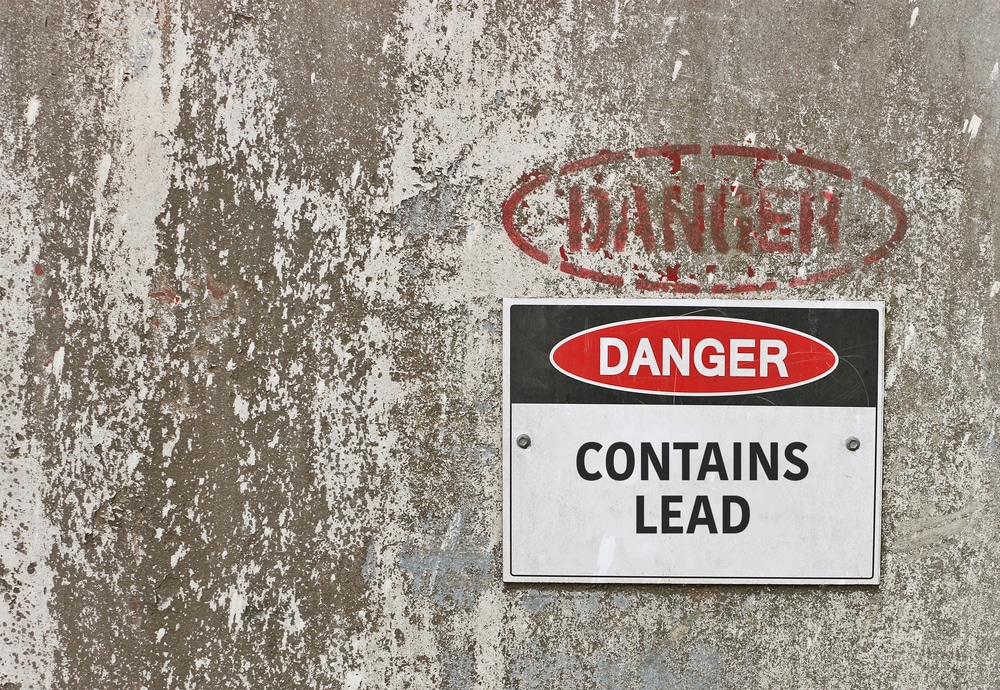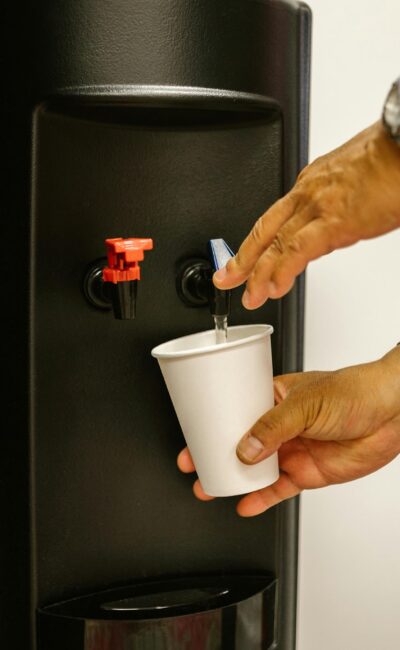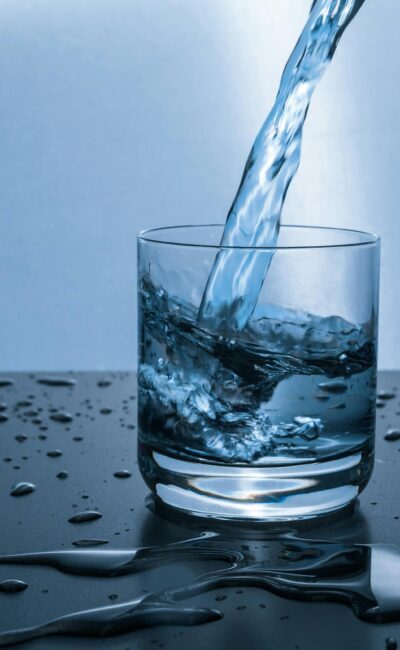Tap water contains chemicals, pollutants, and other contaminants that make it way from the source, through your pipes, and eventually pouring out of your faucet. Lead is a chemical element that is one of the primary contaminants found in household faucets. Because of the use of lead solder in household plumbing fixtures, the chemicals can find its way into drinking water. It’s usually the result of aging plumbing systems that result in corrosion. Essentially, when water makes its way through old, lead pipes, metal dissolves or wears away from the fixtures and mixes in with the water.
According to the Centers for Disease Control and Prevention (CDC), the amount of lead that enters the water is linked to several factors including:
- Water acidity or alkalinity
- Types and amounts of minerals found in the water
- Water temperature
- The amount of lead the water comes into contact with
- Wear on the pipes
- Presence of any protective pipe coating
- Length of the time water stays in the pipes
Water with high acidity is more likely to lead to a lack of corrosion control in the pipes. Plus, older homes (those built before 1986) may still have lead water service lines that connect the main water supply with the home’s plumbing system. Although lead plumbing materials aren’t as common as they once were, many homes and businesses still have brass or iron pipes that have been soldered with lead.
While the Safe Drinking Water Act, established in 1974, has set forth regulations to prevent lead in drinking water, there’s still an allowable percentage of contaminants that meet guidelines because they’re not deemed harmful to human health. Amendments have been introduced to the Act and, as of September 1, 2020, the U.S. Environmental Protection Agency (EPA), published a final rule that requires “manufacturers or importers certify that their products meet the requirements using a consistent verification process within 3 years of the final rule publication date in the Federal Register” to reduce lead in drinking water.
Health Risks from Lead in Drinking Water
Not only is lead a toxic metal, but it also accumulates in the body over time. There are no identified safe blood lead levels. Initially, you may not experience any adverse health effects, but drinking water that contains lead may lead to health problems with time, particularly in children and women who are pregnant. Small doses of lead that may have little effect on adults may have a significant effect on children, who have an increased susceptibility to lead poisoning. Lead exposure in children can result in:
- Behavioral and learning problems
- Delayed growth
- Lower IQ
- Hyperactivity
- Anemia
Pregnant women who drink water containing lead may experience reduced growth of the fetus or premature birth. However, adults are still susceptible to adverse health risks as well when exposed to lead in drinking water, such as decreased kidney function, increased blood press, and reproductive problems. Other possible side effects include abdominal pain, mood disorders, and difficulties with memory or concentration.
For the most part, bathing in lead-contaminated water is deemed safe since skin doesn’t absorb lead in water. It truly depends on the levels of lead in your drinking water and system and how stringent your local water authority’s testing is. A blood test conducted by your healthcare provider is the only way to confirm lead contamination.
It’s critical to be aware of health risks caused by lead in your home system, as well as at your office, children’s school, and any other areas where you and your family members may be drinking from the tap. In addition to lead exposure from water, lead hazards can stem from peeling paint surfaces, play area, and playground equipment. Because lead accumulates in the system over time, eliminating exposure as much as possible is crucial.
Reducing Lead Levels in Your Water System
To understand the lead levels in your water system, you have to go to the source. Since you can’t taste, see, or smell lead in drinking water, determine if you have a lead service line, and have your water tested by your local water utility. If your current water system doesn’t meet the EPA’s Lead Action Level, the responsibility falls to the utility and homeowner to have it replaced.
It’s recommended to flush your home’s pipes by running the tap or taking a shower before drinking from the tap. This is particularly important if your pipes have been off for more than six hours. The goal is to allow fresh water to flow through. Drink and cook with cold water; warm or hot water may have higher levels of lead. Also, clean your faucet’s screen regularly to remove buildup. The EPA requires all water authorities to deliver an annual water quality report referred to as a Consumer Confidence Report (CCR). It alerts you when there’s a problem with your drinking water. With that being said, water quality conditions can change throughout the year before the next report is made available.
These are all ways you can help prevent lead exposure at home, but these same precautions must be taken at work, school, and anywhere else you may rely on tap water for hydration. Depending on your residing area and your plumbing system’s age and state, the best option is likely to drink filtered water for your daily consumption to ensure your water is lead-free.
Lead Testing Varies Per Water Systems
Despite the EPA’s guidelines and the requirements regarding the issuance of a CCR every year, some community water system testing is more stringent than others. This leaves the public water system exposed to more lead than may be reported in the test result based on the data that’s available and the type of testing performed. Since no lead level is deemed safe for human consumption, minor deviations from approved lead levels can still prove harmful.
Furthermore, since a lead service line is expensive and timely to replace, certain areas throughout the country still rely on older plumbing systems. In turn, leaving millions of residents without access to clean drinking water. Lead in drinking water has caused some states, including New Jersey, to turn to other non-sustainable solutions, such as providing plastic water bottles as an alternative.
The most efficient method of reducing exposure to lead and the potential risk of lead poisoning in drinking water is prevention. Knowing the state of your plumbing system and levels of lead in your city’s water are key. However, contaminated water may still be a problem at school, work, or other public areas where you and your family drink from the tap. Drinking filtered water from a system that transforms tap water provides a long-term solution to this problem.
Opt for Filtered Water for Everyday Hydration
Water is essential for everyday life for drinking and cooking. Having filtered water from a filtration system or purified water refilling station that removes chemicals like lead is a healthier way to get your daily hydration without having to worry about what may be lingering in your tap water. Bottled water was once the go-to source for filtered water with minerals and electrolytes, but the increase in plastic waste and the risk of leached chemicals has caused people to look for better alternatives. Enter: FloWater.
FloWater’s hydration stations change tap water via seven different filtration stages for use in public space or at home. Stop stocking up on cases of single-use plastic water bottles or feeling unsure about the quality of your tap water. FloWater provides an option that uses your water source and removes 99 percent of impurities that may be present in your tap water or leach into the water through the pipes.
How FloWater’s Advanced Purification Process Works
Some water filter systems remove all impurities, but don’t replace essential minerals or electrolytes. Other filter systems may not be able to capture the minute sediment or lingering odors that tap water may have. FloWater achieves it all.
First, the sediment filter catches and removes any solid impurities that linger in your water or pipes. After that, the carbon filter captures the smaller particles, such as chlorine, hydrogen sulfide, and radon. It, then, eliminates any unpleasant odors or tastes. In the third stage of purification, an advanced osmosis filter removes the rest of the contaminants that may have made it past the first two stages. These include lead, bacteria, viruses, and other heavy metals and dissolved solids.
Having a filtration system that removes any lingering amounts of lead that may be part of the approved levels in regular tap water ensures you have the cleanest possible water for your daily hydration. After the initial purification steps, the next filter uses activated oxygen. This adds a third atom of oxygen made available for your blood and muscles, improving the water’s taste. Activated oxygen is also used to sanitize the internal system and tanks naturally.
Step five and six are the alkaline and electrolyte enhancement phases. Ten trace minerals are added to the water to neutralize the acidity. Then, electrolytes are added to support cell repair and bone strength. Finally, the unique coconut carbon filter gives FloWater its refreshing taste. By using real coconut husks to absorb tiny particles and odors, it leaves nothing but crisp, purified water that originated from your tap.
Lead in drinking water is all too common when relying on what comes from the tap. To ensure a healthier hydration experience, filtered water is your best bet.
Sources:
- https://www.cdc.gov/nceh/lead/prevention/sources/water.htm
- https://www.epa.gov/ground-water-and-drinking-water/basic-information-about-lead-drinking-water
- https://www.epa.gov/sdwa/use-lead-free-pipes-fittings-fixtures-solder-and-flux-drinking-water
- https://www.mayoclinic.org/diseases-conditions/lead-poisoning/symptoms-causes/syc-20354717
- https://www.epa.gov/sites/production/files/2017-08/documents/epa_lead_in_drinking_water_final_8.21.17.pdf
- https://www.apmreports.org/story/2020/05/04/epa-lead-pipes-drinking-water




